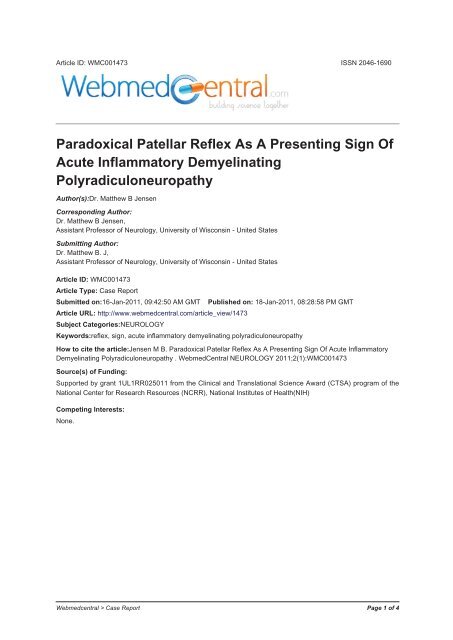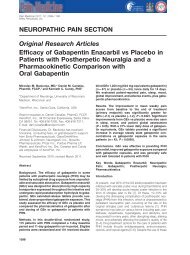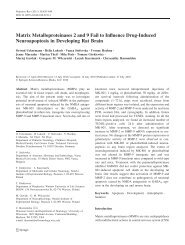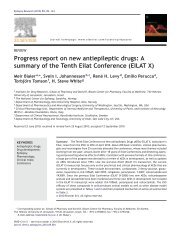Paradoxical Patellar Reflex As A Presenting Sign Of Acute ...
Paradoxical Patellar Reflex As A Presenting Sign Of Acute ...
Paradoxical Patellar Reflex As A Presenting Sign Of Acute ...
Create successful ePaper yourself
Turn your PDF publications into a flip-book with our unique Google optimized e-Paper software.
Article ID: WMC001473 ISSN 2046-1690<br />
<strong>Paradoxical</strong> <strong>Patellar</strong> <strong>Reflex</strong> <strong>As</strong> A <strong>Presenting</strong> <strong>Sign</strong> <strong>Of</strong><br />
<strong>Acute</strong> Inflammatory Demyelinating<br />
Polyradiculoneuropathy<br />
Author(s):Dr. Matthew B Jensen<br />
Corresponding Author:<br />
Dr. Matthew B Jensen,<br />
<strong>As</strong>sistant Professor of Neurology, University of Wisconsin - United States<br />
Submitting Author:<br />
Dr. Matthew B. J,<br />
<strong>As</strong>sistant Professor of Neurology, University of Wisconsin - United States<br />
Article ID: WMC001473<br />
Article Type: Case Report<br />
Submitted on:16-Jan-2011, 09:42:50 AM GMT Published on: 18-Jan-2011, 08:28:58 PM GMT<br />
Article URL: http://www.webmedcentral.com/article_view/1473<br />
Subject Categories:NEUROLOGY<br />
Keywords:reflex, sign, acute inflammatory demyelinating polyradiculoneuropathy<br />
How to cite the article:Jensen M B. <strong>Paradoxical</strong> <strong>Patellar</strong> <strong>Reflex</strong> <strong>As</strong> A <strong>Presenting</strong> <strong>Sign</strong> <strong>Of</strong> <strong>Acute</strong> Inflammatory<br />
Demyelinating Polyradiculoneuropathy . WebmedCentral NEUROLOGY 2011;2(1):WMC001473<br />
Source(s) of Funding:<br />
Supported by grant 1UL1RR025011 from the Clinical and Translational Science Award (CTSA) program of the<br />
National Center for Research Resources (NCRR), National Institutes of Health(NIH)<br />
Competing Interests:<br />
None.<br />
Webmedcentral > Case Report Page 1 of 4
WMC001473<br />
Downloaded from http://www.webmedcentral.com on 19-Jan-2011, 04:51:25 AM<br />
<strong>Paradoxical</strong> <strong>Patellar</strong> <strong>Reflex</strong> <strong>As</strong> A <strong>Presenting</strong> <strong>Sign</strong> <strong>Of</strong><br />
<strong>Acute</strong> Inflammatory Demyelinating<br />
Polyradiculoneuropathy<br />
Abstract<br />
We report a case of paradoxical patellar reflex as a<br />
presenting sign of acute inflammatory demyelinating<br />
polyradiculoneuropathy.<br />
Case report<br />
A 46-year-old man presented with distal limb<br />
paresthesias and dysequilibrium. Four weeks prior he<br />
had a sore throat and dry cough that resolved over two<br />
weeks. One week prior he began to experience brief<br />
episodes of dyspnea while recumbent. Three days<br />
prior he developed progressive low back and lateral<br />
hip pain, symmetric paresthesias of the hands and feet,<br />
and dysequilibrium. The day of presentation he<br />
developed paresthesias of the lips and nose and it<br />
became difficult for him to drink liquids because they<br />
would run from the sides of his mouth.<br />
His vital signs, general physical examination, and<br />
mental status were normal. There was mild symmetric<br />
upper and lower bifacial weakness. Strength, tone,<br />
and coordination were normal. Somatosensation was<br />
normal except for symmetric dysesthesias of the<br />
hands and feet. Gait was normal except for mild<br />
unsteadiness with tandem walking. Muscle stretch<br />
reflexes, other than the patellar tendons, were<br />
moderately hyperactive throughout, and severely so at<br />
both Achilles tendons with three beats of clonus.<br />
Percussion of either patellar tendon elicited no<br />
extension at the knee or contraction of the quadriceps,<br />
but instead knee flexion occurred with visible and<br />
palpable contraction of the hamstrings. Percussion of<br />
the medial knee did not elicit bilateral adductor<br />
contraction.<br />
The cerebrospinal fluid had an elevated protein of 151<br />
mg/dl and one white blood cell. Nerve conduction<br />
studies showed diffuse slowing and conduction block<br />
suggestive of demyelination, as well as absent F<br />
waves bilaterally.<br />
Over the subsequent days, the bifacial weakness<br />
progressed to absence of volitional contraction, and he<br />
developed moderate weakness of bilateral hip and<br />
knee flexors and extensors. He lost the paradoxical<br />
patellar reflex, and all the muscle stretch reflexes<br />
became hypoactive with continued absence at both<br />
knees. He stabilized after several days of intravenous<br />
immunoglobulin treatment, and after two weeks he<br />
began to regain strength in the proximal legs, although<br />
the bifacial weakness gradually resolved over months.<br />
Discussion<br />
This patient presented with diffuse hyperreflexia,<br />
initially casting doubt on the diagnosis which<br />
subsequently declared itself over the following days.<br />
Cases of acute inflammatory demyelinating<br />
polyradiculoneuropathy (AIDP) presenting with initial<br />
hyperreflexia has been reported 1-3 . The mechanism of<br />
this phenomenon is unclear, as the usual<br />
characteristic of this disorder is hyporeflexia<br />
secondary to demyelination of peripheral nerves.<br />
The unusual finding of hyperreflexia in case appeared<br />
to provide the substrate for another confounding sign:<br />
the presence of an inverted or paradoxical patellar<br />
reflex. We are aware of only a single report of two<br />
patients with an “inverted knee jerk,” occurring with a<br />
low spinal cord lesion 4 . In the setting of spread of<br />
muscle stretch reflexes to neighboring muscle groups<br />
if opposing muscles are differentially affected such<br />
that the reflex of one is lost while the other is<br />
increased, striking the tendon of the muscle with the<br />
lost reflex could be enough stimulation to the opposing<br />
muscle group to trigger its reflex loop, giving rise to<br />
paradoxical movement of the tested joint. This type of<br />
muscle stretch reflex spread is typically seen with<br />
cervical spinal cord lesions where striking the<br />
brachioradialis tendon may cause no response in that<br />
muscle but finger flexion instead 5 .<br />
The clinical, cerebrospinal fluid, and electrophysiologic<br />
findings of this case are compatible with the diagnosis<br />
of AIDP, but early in the patient’s course there were<br />
two clinical findings rarely encountered with this<br />
condition, both of which could be potential sources of<br />
Webmedcentral > Case Report Page 2 of 4
WMC001473<br />
Downloaded from http://www.webmedcentral.com on 19-Jan-2011, 04:51:25 AM<br />
diagnostic confusion.<br />
References<br />
1.Kuwabara S, Ogawara K, Koga M, Mori M, Hattori T,<br />
Yuki N. Hyperreflexia in Guillain-Barré syndrome:<br />
relation with acute motor axonal neuropathy and<br />
anti-GM1 antibody. J Neurol Neurosurg Psychiatry.<br />
Aug 1999;67(2):180-184.<br />
2. Kuwabara S, Nakata M, Sung JY, et al.<br />
Hyperreflexia in axonal Guillain-Barré syndrome<br />
subsequent to Campylobacter jejuni enteritis. J Neurol<br />
Sci. Jul 2002;199(1-2):89-92.<br />
3. Oshima Y, Mitsui T, Endo I, Umaki Y, Matsumoto T.<br />
Corticospinal tract involvement in a variant of<br />
Guillain-Barré syndrome. Eur Neurol.<br />
2001;46(1):39-42.<br />
4.Boyle RS, Shakir RA, Weir AI, McInnes A. Inverted<br />
knee jerk: a neglected localising sign in spinal cord<br />
disease. J Neurol Neurosurg Psychiatry. Nov<br />
1979;42(11):1005-1007.<br />
5.Brazis PW, Masdeu JC, Biller J. Localization in<br />
clinical neurology. 3rd ed. Boston, Mass.: Little, Brown;<br />
1996.<br />
Acknowledgement(s)<br />
Supported by grant 1UL1RR025011 from the Clinical<br />
and Translational Science Award (CTSA) program of<br />
the National Center for Research Resources (NCRR),<br />
National Institutes of Health(NIH).<br />
Webmedcentral > Case Report Page 3 of 4
WMC001473<br />
Downloaded from http://www.webmedcentral.com on 19-Jan-2011, 04:51:25 AM<br />
Disclaimer<br />
This article has been downloaded from WebmedCentral. With our unique author driven post publication peer<br />
review, contents posted on this web portal do not undergo any prepublication peer or editorial review. It is<br />
completely the responsibility of the authors to ensure not only scientific and ethical standards of the manuscript<br />
but also its grammatical accuracy. Authors must ensure that they obtain all the necessary permissions before<br />
submitting any information that requires obtaining a consent or approval from a third party. Authors should also<br />
ensure not to submit any information which they do not have the copyright of or of which they have transferred<br />
the copyrights to a third party.<br />
Contents on WebmedCentral are purely for biomedical researchers and scientists. They are not meant to cater to<br />
the needs of an individual patient. The web portal or any content(s) therein is neither designed to support, nor<br />
replace, the relationship that exists between a patient/site visitor and his/her physician. Your use of the<br />
WebmedCentral site and its contents is entirely at your own risk. We do not take any responsibility for any harm<br />
that you may suffer or inflict on a third person by following the contents of this website.<br />
Webmedcentral > Case Report Page 4 of 4






